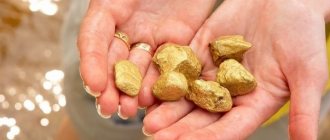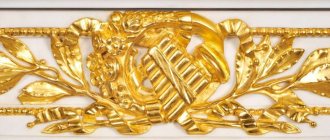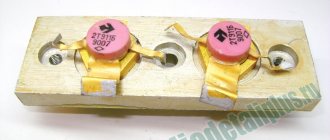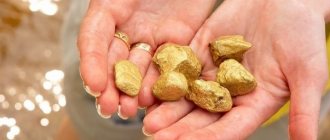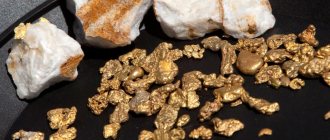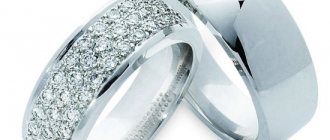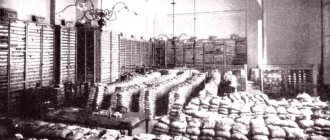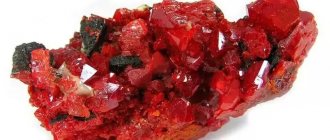Did you know that in order to feel like a gold digger, there is no need to go to the mine? Gold is found in electronic devices that surround us every day. You just need to know exactly where to look and what to pay attention to.
However, do not rush to disassemble the system unit in search of gold bars. A small, literally microscopic amount of gold is found only in some radio components that make up electronic devices.
More precisely, it would be more correct to call these elements “electronic components,” but the label “radio components” has been firmly attached to them since they began to be widely used to create amateur radio receivers a little less than a century ago.
It was the radio components of those years that contained the largest amounts of gold. Where it came from is a separate and very interesting question.
Gold content in radio components - quantity, cost, extraction tips
Extracting gold from radio components and devices is profitable, despite changes in the quality of available raw materials .
The demand for gold is growing and the resources for recycling suitable raw materials are still far from exhausted.
Gold is a precious and noble metal.
It has long been used to perform three main tasks and functions :
- in jewelry;
- as a means of payment and an instrument for the circulation of capital;
- in technology.
The use of gold in technology is limited only by the high cost of this metal. The scale and direction of use of gold are determined by a unique set of its qualities , among which the most important are:
- Complete resistance to corrosion and inertness to other substances and materials.
- Very low electrical resistance.
- High thermal conductivity.
- High softness, ductility.
- Possibility of producing very thin layers of gold.
Gold is widely used in the manufacture of radio components, electronics, and instrument making. In the article we will tell you which devices and their parts contain this noble metal and which contain it the most.
Where to find and obtain radio components containing precious metals
Dear Internet users! Send your photos and notes about where and in what devices you came across radio components containing precious metals.
The list of decommissioned and subject to disposal devices, various units and radio communication units, containing precious metals in radio components and radio-electronic components in their composition, is simply huge. Ever since the collapse of the Soviet Union, when everything and everyone fell apart, when chaos and confusion reigned in the country, salaries were not paid, and many, in order to earn at least some money and feed their families, brought home and then dismantled various decommissioned electronic devices into radio components with precious metal devices from institutes and organizations. Until now, such devices are still gathering dust and awaiting their fate in garages, country houses, and sometimes in the open air, covered with corrosion. Well, let's start with the most common one.
Let's say right away that almost all radio components are on the boards. Transistors KT-803, KT-808, KT-809, KT-812, KT-908, KT-912 are usually located in the rear of the devices on aluminum radiators, transistors KT-911, 2T-911B are located on an aluminum base, for heat dissipation on the board.
Switches 11P 3N are attached to the body, and resistors PTP, PP3-41, PP3-43, PP3-47 can be located on a metal base inside the block or attached to the body of the device.
Therefore, you first need to find and disassemble the device or unit, remove the boards, and only after that extract radio components with precious metal. We must be prepared for this. There is an opinion that
TVs made in the USSR contain many valuable radio components. In fact, and in most cases, you can find several green KM5 capacitors there, and less often red KM6 capacitors. And also several KT-203 transistors, which cost 5-6 rubles each. Perhaps, if the TV is from the 60s-70s, you should pay attention to the lamps.
You can spend a fair amount of time disassembling such a TV, not to mention the size and weight of the TV itself. The situation is similar for radios, tube receivers, and tape recorders. Quite a lot of KM6 capacitors are red in color, less often green in Soviet VCRs of the VM series. There are also yellow and blue ceramic capacitors K10-17.
The record holders for the content of precious metals are, of course, computer systems, automatic telephone exchanges and special electronic devices manufactured in the USSR.
But, unfortunately, such computer systems are very rare these days. So you can leave and forget about wondering where to find them. The most important thing in this matter is attentiveness. Radio components can sometimes be located in inconspicuous metal boxes and blocks. If you find a metal box with the following connectors:
This means you are on the right track and disassembly to remove radio components can begin. You should also pay attention to the following parts and components with white contacts:
Many radio components with precious metal are found in measuring and computing instruments, such as: high-frequency generators, frequency meters, frequency synthesizers, electronic voltmeters, oscilloscopes and other devices. The population density in such electronic devices is very high. But you still need to remove their protective casings and look at what’s inside. Sometimes practically nothing.
The measuring devices and instruments listed above, the initial series and the first modifications, practically do not contain radio components with precious metal. These devices are distinguished by their large size (both the body itself and individual knobs, switches, and other parts) and weight.
Such devices contain powerful transformers - this partly explains the large weight of the product. Therefore, when disassembling such devices, it is first better to look at the table of the content of precious metals in the devices in order to have an initial idea of what kind of device you have found and what can be extracted from it.
Sometimes you can find instruments and devices that are not
a hand will rise. They contain little precious metal inside, but as a product they are valuable for radio amateurs. Therefore, you can always try to find a person who will buy this device in working condition. Or just don't break it. From the point of view of a radio amateur, disassembling devices and selling radio components for scrap is perceived extremely negatively and many unflattering words can be heard about this.
Radio amateurs with extensive experience treat radio components completely differently. For them, every radio component is of real value, be it a microcircuit or a transistor, and is sometimes perceived as an inspired object. The current young generation, in most cases, perceives radio engineering and radio electronics produced in the USSR as a gold miner perceives a river bed.
Why is gold used in devices?
Recycling – technologies for recycling production waste, used materials and products .
The importance of this economic direction has opened up for many the scale of the use of gold in electronics, radio, and in the manufacture of devices.
The main reason for using expensive metal in such products is the possibility of producing very small, corrosion-resistant conductive elements
In many cases, it is important to ensure the miniature dimensions of radio components and their parts.
Gold is used when it is necessary to minimize the risk of sparks and even the slightest corrosion.
Here are the main forms of using gold in radio components and devices:
- Using gold foil.
- Installation of gold coatings - sputtering, galvanic gilding.
- Manufacture of small parts with precise and stable properties.
Most often, the use of gold in parts and products remains invisible during external inspection and even disassembly.
Only gold-plated contacts, some solid parts, and conductors remain visible.
Recycling experience and knowledge of the design of radio components helps in returning gold to economic and industrial circulation.
The extraction of gold from radio components is based on several important factors :
- A large number of these products, including those completely unsuitable for use.
- High purity of gold in products of this kind.
- Possibility of extracting other valuable metals along with gold.
Connectors, pins, lamellas
Since the main purpose of gold in electronics is to protect contacts from corrosion, it can be found as a coating on the contact pins of plugs and connectors, as well as in the contact strips of lamellas.
Even compared to gold-plated Soviet microcircuits, it is difficult to find contact surfaces that were used in computers and in switching units of automatic telephone exchanges. But if this is successful, then a lot of gold can be extracted - up to several grams from one connector.
These are not all Soviet radio components that contain gold. But the rest are either extremely rare and in single quantities, or have such a small amount of gold that its extraction is unprofitable.
Radio tubes
The use of radio tubes in electronic technology has long lost its widespread character .
However, considerable stocks of these electronic devices are still kept by the population and even in some enterprises.
Gold in lamps was used for sputtering and gilding. Some lamp models contain very large amounts of precious metal.
In radio tubes you can find grids coated with a layer of gold, contacts, and other parts.
The general technological extraction scheme is complicated by the abundance of valuable metals that can be returned to production and other areas.
Here are some examples of gold content in Soviet-made radio tubes:
| Brand of radio tube | Gold content, grams per thousand lamps |
| 12P17L | 1,58 |
| 6ZH9G-V | 5,57 |
| 6P45S | 28,65 |
| GI-19B | 319.70 |
| GI-42B P3 | 86647.00 |
Microcircuits
The use of gold in microcircuits is due to the high electrical conductivity of this metal. Its use makes it possible to achieve miniature sizes and reliability of contacts, soldering and other types of connections.
Precious metal in microcircuits is necessary to create corrosion-resistant, thin, low-resistance conductive lines.
Modern technologies make it possible to create such elements in the form of the thinnest coatings. The percentage of gold in microcircuits is low, but working with large quantities of such raw materials becomes cost-effective and profitable.
The table below shows which microcircuits contain gold (grades in which it is used) and how much it is.
| Chip brand | Gold content in milligrams |
| KR531KP12 | 0.55 |
| 1109KT5 | 25.54 |
| KR1005ХА4 | 0.80 |
| K1108PA15 | 35.25 |
| K101KT1V | 17.97 |
Domestic radio components
The champions in gold content are radio components that were manufactured in the USSR before 1986.
Most of these treasures were found in space and military technology, in measuring and computing instruments, sensors and other devices, the operation of which had increased requirements for accuracy and reliability.
Extremely rarely, according to the residual principle, radio components with a high gold content were installed in ordinary consumer electronics: televisions, players and radios.
You should not disassemble old Soviet measuring equipment into radio components if it is working or requires minor repairs. In its entirety, it costs significantly more than what you can get for the parts.
Most Soviet gold-plated electronic components have already been collected and melted down, but you may still come across them when disassembling your grandmother's old TV or boxes of radio parts that belonged to your grandfather. Therefore, it is necessary to know exactly which radio components contain gold, so as not to accidentally throw them away or sell them for next to nothing.
Transistors
The gold content in transistors makes mining this metal profitable.
Some types of KT series transistors can produce up to 0.2 grams of precious metal.
Other valuable metals are also found in transistors :
The efficiency of mining gold and other metals depends on sorting. Skillful selection of raw materials allows you to more accurately determine the technology, and therefore reduce the cost of the process of extracting precious metals, and obtain a more complete yield of the final product.
Which radio components contain the most gold?
The older the part, the more precious metal it contains, since the technology for its application was still poorly developed and an order of magnitude less effective. Efficiency leaps have occurred over the past 40 years, so radio components manufactured before 1990 contain the most gold.
On radio components manufactured in the 70-80s of the 20th century, gold plating with a thickness of 1-2 microns was often used, but in modern electronic components such a thickness is extremely rare and usually this layer is measured in tenths and even hundredths of a micron.
Of course, not all electronic components contain gold. And it is quite difficult to determine its presence on your own. Therefore, we will dwell in detail on which radio components contain the most gold.
Relays and connectors
Relays and connectors are important parts of electrical installations and electronic circuits. Contacts are the main component of such devices.
Contacts coated with a layer of gold have several advantages:
- simplicity and reliability of soldering;
- low risk of sparking;
- lack of resistance at the point of contact;
- no corrosion.
Many types of electrical equipment have gold-plated contacts . Such contacts are found in many types of connectors and relays.
Extracting gold from relay contacts and connectors is easier than when processing radio components.
This is explained by the fact that gold in such raw materials is the only precious metal that requires extraction.
Instruments and equipment
Gold is used in precision equipment, especially in older models .
Here are some examples of devices and instruments powered by electricity, indicating the amount of precious metal:
| Type or model of equipment or device | Estimated amount of recoverable gold in grams |
| Oscilloscope C 9 - 1 | 3,439 |
| Programmer 815 | 21,4845 |
| Milliohmmeter E 6-18/1 | 0,333 |
| Frequency meter ChZ-68 | 8,1 |
| Generator G 2-59 | 11,09334 |
Precious metal in devices is most often used for coatings, but parts made from this metal are also found.
Disposing of devices after repeated use is a profitable activity.
Do-it-yourself gold extraction
Those interested in recycling can begin work in this direction by collecting gold-containing raw materials. Studying the indicators of radio components, methods of their primary processing and sorting will create a good basis for further work .
The presence of conditions in the home will allow amateurs to engage in practical gold extraction. It is important to know:
- About the dangers of working with toxic and caustic substances, about safety precautions.
- On the technology of laboratory work in chemistry.
- About legal methods of collecting raw materials and marketing the resulting metal.
The basic condition for working in the field of precious metals recycling is compliance with the law .
The only easiest and safest way to work in the field of precious metals recycling is to cooperate with a registered company that knows and complies with the requirements of the laws.
Independent work can be carried out on assignments from a company where the consumer can return a valuable device for recycling.
How to get gold from radio devices
Only two methods of refining gold have been invented - extracting the precious metal from impurities and alloys
- Using chemical reactions - chemical method.
- Using electrolysis - physical.
Chemical
The method of chemical purification from impurities is carried out by the interaction of various acids with the components of radio spare parts.
To carry out a chemical reaction, you need a well-ventilated area.
- A solution of acids called “regia vodka” is prepared. To do this, you need to take 1 liter of sulfuric acid, 250 grams of hydrochloric acid, then heat the mixture to 55-60 degrees. The parts are lowered into the liquid medium, and then nitric acid is added in a small amount (100-150 grams). The solution is prepared immediately before use so that the acid does not disintegrate. When the oxidation reaction is completed, reduction must begin. To do this, use copper sulfate or tin chloride.
- There is also a method of oxidation in nitric acid. It is also quite effective. In this case, gold-containing raw materials are immersed in concentrated nitric acid. Glassware is used to carry out the reaction. After a few hours of being in an aggressive environment, all the parts will dissolve, and only inert gold will appear in the sediment. It is isolated using baking soda, after draining the solution first.
- There is a simpler, but longer method of chemical purification of precious metal. To do this, prepared products containing gold are dipped in a mixture of hydrochloric acid and hydrogen peroxide (2:1). Gold-containing parts are filled with the prepared reagent. The reaction proceeds for a week with daily stirring. As a result, gold grains will precipitate, which are filtered and washed in water.
Physical cleaning method
For physical cleaning (using an electrolyte), it is necessary to use gold chloride and hydrochloric acid. The anode is 99-karat gold, and during the catalysis process, gold grains will attach to the cathode.
To carry out the catalysis process, a direct current is passed through the cathode and anode, creating an electrical circuit.
Collection and operations with radio components
When doing recycling, you don’t have to perform the full cycle of work:
- Collection of raw materials.
- Sorting and primary processing.
- Gold recovery and refining.
- Melting and sale of ingots.
Cooperation with a specialized company makes it possible to limit yourself to those works that conditions allow. Many individual enthusiasts limit themselves only to collecting and sorting radio components.
Here are several channels for searching and collecting such raw materials:
- collection from ownerless abandoned industrial and other facilities;
- collection from the population.
The photo above shows some parts containing gold, and the table shows a list of them with some average prices for them in Russia:
| Type of radio components | Cost per unit of weight or quantity, rub. |
| Microcircuit 153UD1 new | RUB 36.1 each |
| Microcircuit 153UD1 used | RUR 25.05 per piece |
| New M85 chip | 129.52 rubles per piece |
| Microcircuit M85 used | 111.36 rubles per piece |
| Transistors KT301, 306, 312, 316 new | RUR 26.90 per piece |
| Transistors KT301, 306, 312, 316 used | 18.00 RUR per piece |
| Transistors KT930, 958, 960, 970 new | 90.67 rub. per piece |
| Transistors KT930, 958, 960, 970 used | 74.96 RUR per piece |
| Lamp GS-36B | 196.47 rubles per piece |
| Lamp GMI-29B-1 | RUB 7,841.04 per piece |
Gold is found not only in radio components. Read about where else you can find it here.
